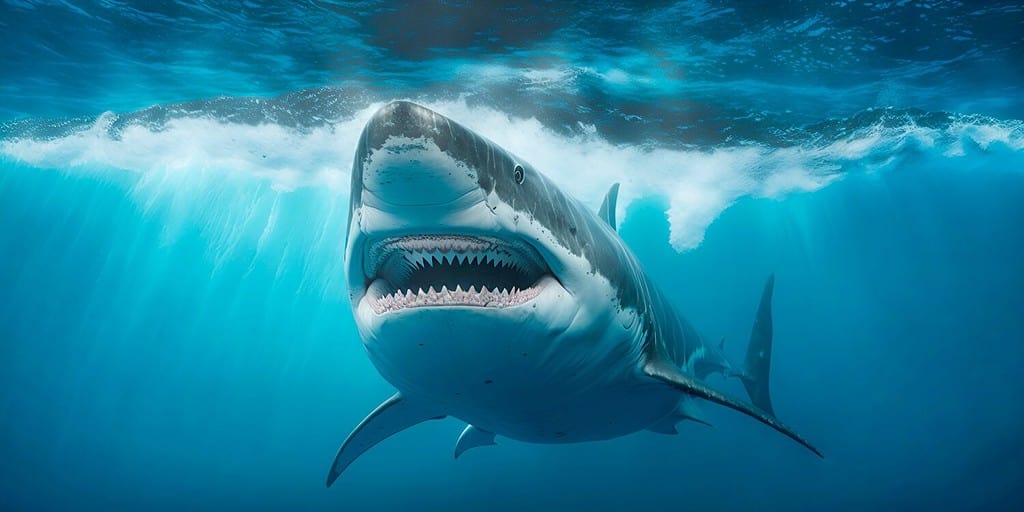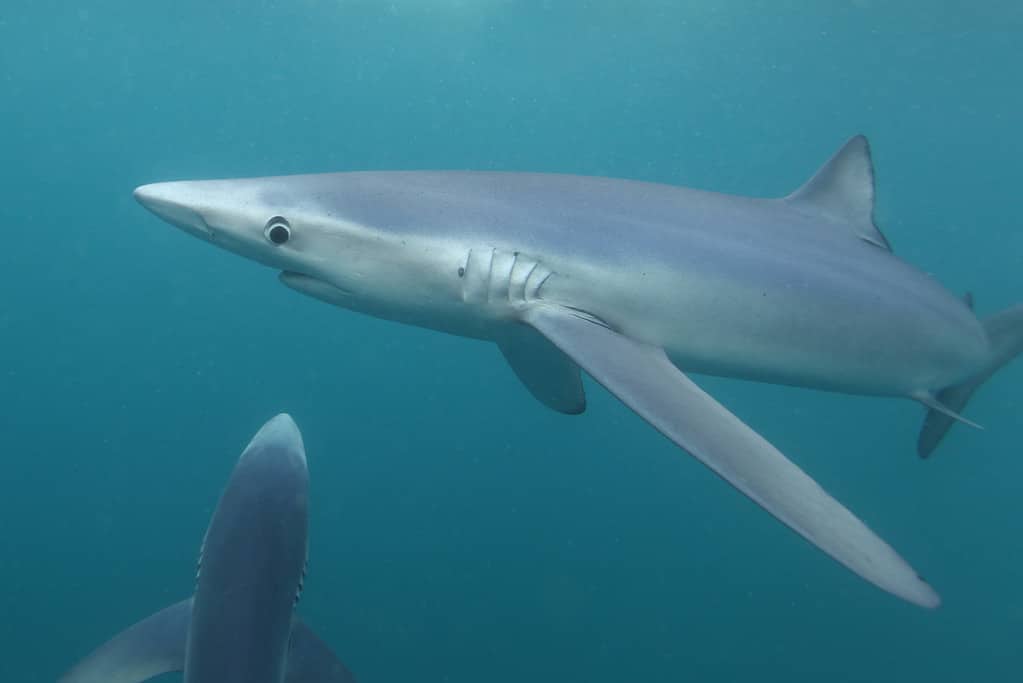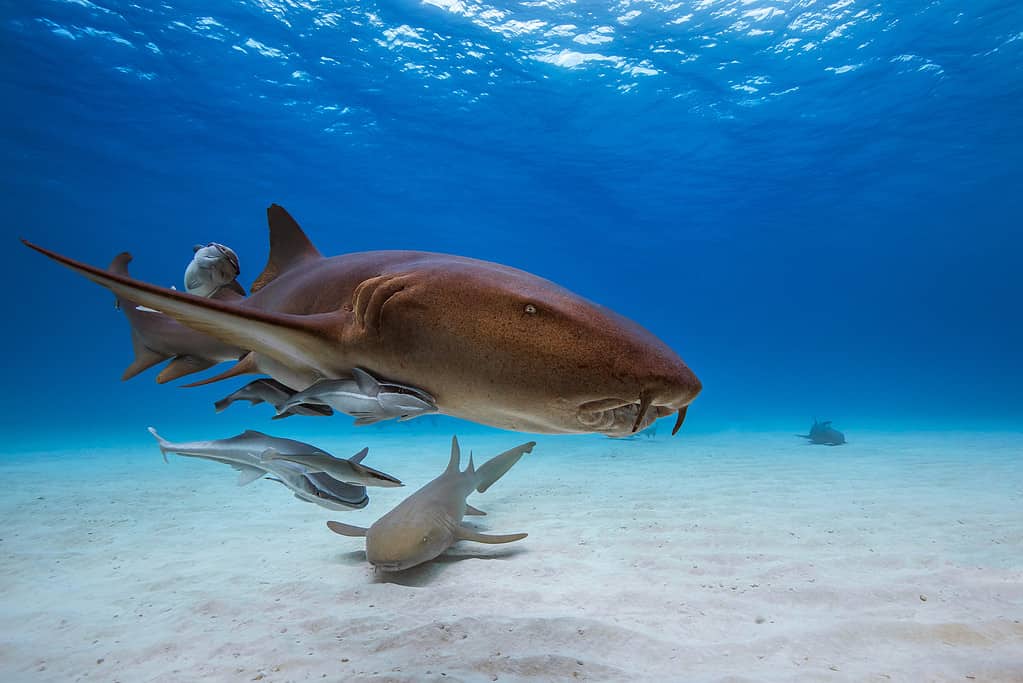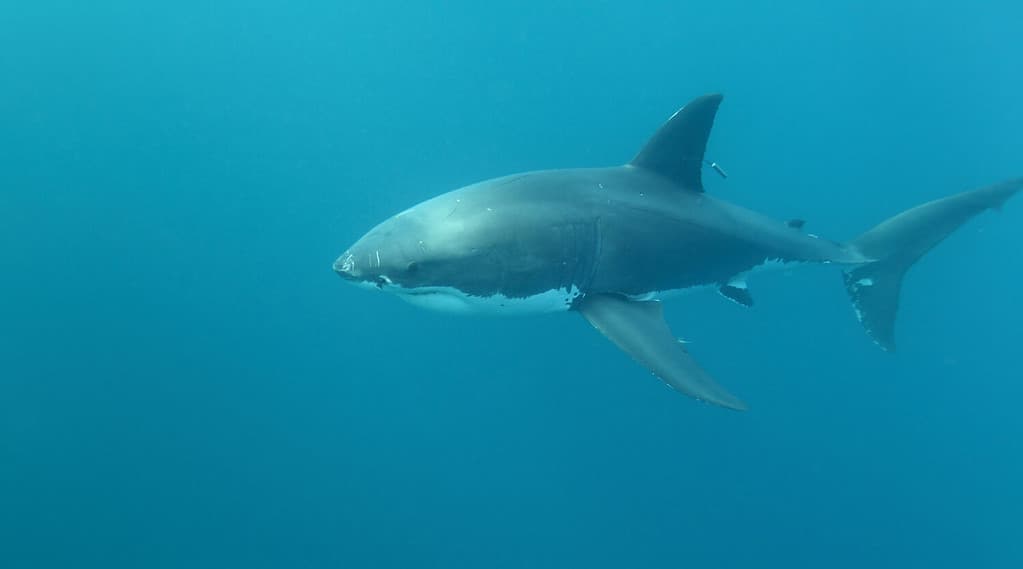
When diving or swimming in the ocean, it’s practical to consider the colors you wear. Sharks, with their unique vision, are drawn to certain shades more than others. In this article, we’re breaking down the top five colors that are most likely to get their attention, offering insights for safer marine interactions.
Shark’s Color Vision
Sharks navigate their watery world with an interesting mix of sensory tools. Their eyes share similarities with ours regarding vision, including components like the pupil, iris, and retina. Yet, a unique feature called the tapetum lucidum sets them apart. This reflective layer, positioned behind the retina, doubles the light exposure, significantly enhancing their vision in dim waters.
Vital to understanding shark vision is the distinction between rods and cones. Rods, which sharks possess in abundance, detect light and darkness, while cones discern colors. However, most sharks have a limited number of cones. Research on various shark species found that many either lack cones altogether or have just a single type, a long-wavelength sensitive cone.
What does this mean? Sharks with no cones can’t differentiate colors, and those with only the long-wavelength cones see a minimal spectrum. In essence, many sharks are likely colorblind, leaning heavily on their ability to detect contrasts.
This heightened sensitivity to contrast, rather than a range of colors, is crucial for their survival, allowing them to spot prey and navigate murky ocean depths efficiently.
Yellow

In essence, many sharks are likely colorblind, leaning heavily on their ability to detect contrasts.
©LuckyStep/Shutterstock.com
The color yellow, dubbed “yum-yum-yellow” among marine enthusiasts, has a reputation for attracting sharks, notably the formidable Great White. Why is this seemingly cheerful color so captivating to these apex predators? Considering the previously discussed color vision of sharks, their attraction to yellow isn’t about the color itself but the contrast it creates in the marine environment.
In the blue-green backdrop of the ocean, vibrant yellow stands out starkly, providing a high-contrast target. This makes it easily distinguishable even for sharks that can’t discern the full spectrum of colors. Many of the natural prey items of sharks, such as certain fish species, have lighter underbellies or reflective scales.
The bright yellow mimics these prey’s appearance or reflectiveness, oftentimes drawing the shark’s attention.
Red

Considering the previously discussed color vision of sharks, their attraction to yellow isn’t about the color itself but the contrast it creates in the marine environment.
©Vladimir Wrangel/Shutterstock.com
At first glance, one might assume that the deep blue oceans would mask the vibrancy of red, rendering it invisible to marine life. While this is partly true, as red light is absorbed quickly in water and the color appears muted or even black at depth, its effects on attracting sharks differ.
In water depth, red is the first color to be filtered out, disappearing beyond 15-20 feet, and turning into a murky gray or black. This means in deeper waters, red doesn’t stand out as the vibrant hue we perceive on land; rather, it contrasts sharply with the surrounding water, creating a silhouette.
While red might not have the same magnetism as the “yum-yum-yellow,” its changing appearance at different depths creates contrast, especially against a blue-green ocean background. When bleeding prey is considered, the color in the water attracts sharks due to the contrast and movement rather than the actual hue of red.
Orange

Sharks can also see the vibrancy of the color red.
©Alessandro De Maddalena/ via Getty Images
Due to its rarity underwater, orange acts as a signal to a shark. It contrasts sharply with the surrounding environment, making it easy for sharks to spot. Their attraction to orange isn’t the color but its standout nature against the typical aquatic backdrop. While many colors fade or morph with depth, orange remains relatively consistent. It retains visibility even as one descends further. This constant visibility makes objects or individuals sporting the color particularly noticeable.
Metallics

While many colors fade or morph with depth, orange remains relatively consistent.
©Carlos Grillo/ via Getty Images
Sharks heavily rely on contrasts to detect objects. The gleaming appearance of metallics stands out against the muted backdrop of the sea. With their heightened sensory perception, these creatures quickly notice the irregular flashes and reflections created by metallic surfaces. Like certain fish species, natural prey have scales that can reflect light, mimicking a metallic sheen.
Thus, to sharks, anything with a metallic gleam might resemble potential prey or at least be worthy of investigation. This association can be powerful in murky waters or during times of day when light penetration is reduced, making contrasts even more crucial.
Reflective Materials

ike certain fish species, natural prey has scales that can reflect light, mimicking a metallic sheen.
©Alessandro De Maddalena/Shutterstock.com
Reflective materials, whether part of diving gear, swimwear, or accessories, possess a distinct allure in the aquatic realm. Unlike standard colors that rely on inherent hues, reflective materials play with light, bending and bouncing it in different directions, similar to metallics. Sharks, with their keen emphasis on detecting contrasts and movements, are especially attuned to these unpredictable light patterns.
These intermittent reflections become even more pronounced in the ever-shifting light dynamics of underwater environments, especially in murkier waters. They can simulate the erratic movements of wounded or smaller prey, triggering the predatory instincts of sharks.
Summary of 5 Colors That Attract Sharks
| Color | |
|---|---|
| 1 | Yellow |
| 2 | Red |
| 3 | Orange |
| 4 | Metallics |
| 5 | Reflective Materials |
The photo featured at the top of this post is © Alessandro De Maddalena/Shutterstock.com
Thank you for reading! Have some feedback for us? Contact the AZ Animals editorial team.






